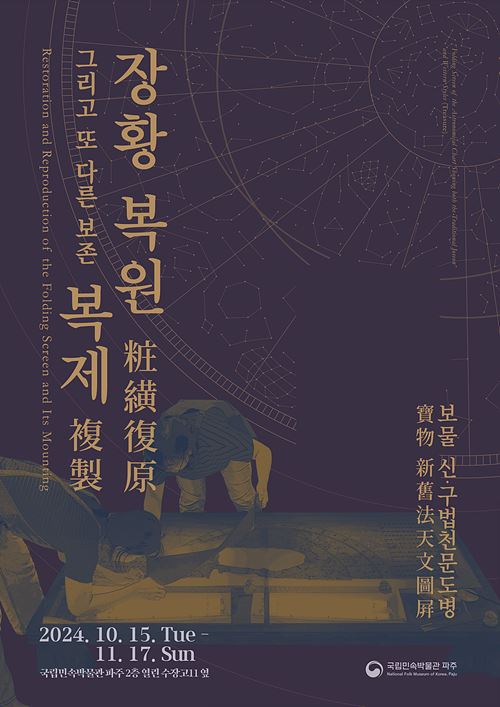Exhibitions
| Title | Restoration and Reproduction of the Folding Screen and Its Mounting | ||||||||||
|---|---|---|---|---|---|---|---|---|---|---|---|
| Period | October 15(Tue.), 2024-November 17(Sun.), 2024 | ||||||||||
| Venue | The second floor at National Folk Museum of Korea, Paju | ||||||||||
|

This painting is an astronomical chart that includes the traditional Joseon celestial chart, Cheonsang yeolcha bunyajido(天象列次分野之圖, literally “Celestial Chart of the Divisions of the Sky”), along with the Western-style celestial map created during the reign of King Yeongjo (r. 1724–1776) known as Hwangdo nambuk yangchongseongdo(黃道南北兩總星圖, “Celestial Map of the Northern and Southern Ecliptic Hemispheres”). During the restoration process, it was discovered that this map is one of the oldest versions among the nine existing the astronomical chart showing both the traditional Joseon and western styles.
This chart was found hidden beneath the painting of a folding screen. When it was acquired by the National Folk Museum of Korea in 1995, the chart was segmented into eight pieces and severely damaged. Due to a lack of references to determine its original form, it was repaired to a minimum level in 2000 without being reconstructed into a folding screen. However, as it was difficult to fully appreciate the chart in its fragmented state, restoring it as a folding screen became necessary. After several years of research, a total of nine the astronomical chart showing both the traditional Joseon and western styles were found at home and abroad. Using these examples, as well as the lining paper and fabric originally used to decorate the screen, both of which were kept in the museum’s storage, the current folding form was reconstructed.
Paintings, calligraphy, wood, and textile works can be vulnerable to damage from environmental factors, such as humidity, temperature, and light. After these items have been exhibited for a period of time, it is necessary for them to rest in a proper storage environment for preservation purposes. Sometimes replicas allow more people to experience and learn about the museum’s collection. When the museum’s collection is too fragile or in an unstable condition, replicas are made for educational and research purposes.
Furthermore, it is hoped that the exhibition provides a chance to reflect on the significance of reproducing valuable cultural heritage.
Materials
|
|||||||||||
| Date | 2024-10-16 | ||||||||||
| 이전글 | What a Brew-tiful day! |
|---|---|
| 다음글 | PARADE |









